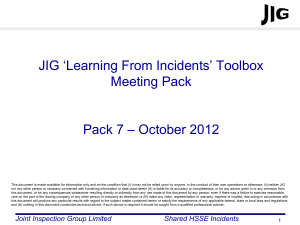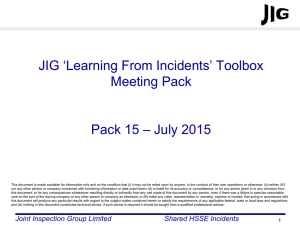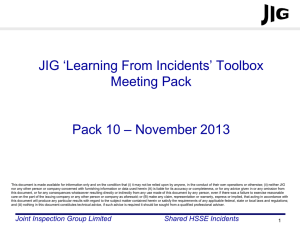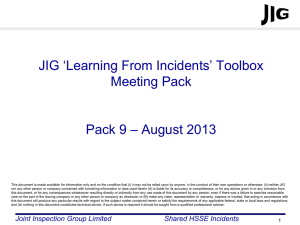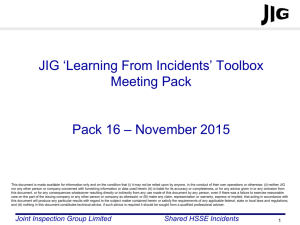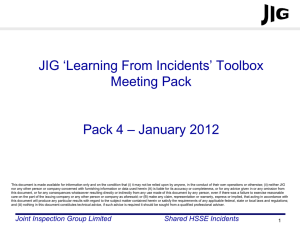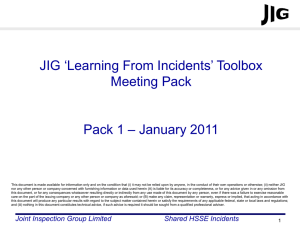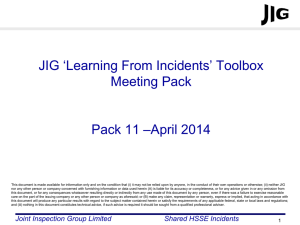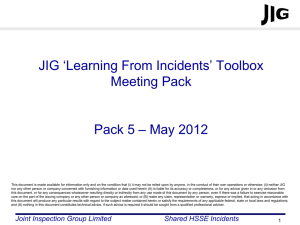Joint Inspection Group Limited Shared HSSE Incidents
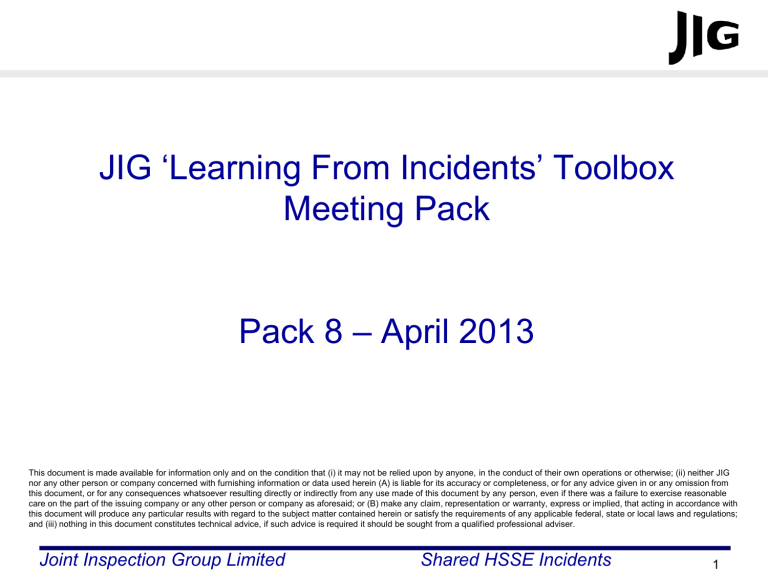
JIG ‘Learning From Incidents’ Toolbox
Meeting Pack
Pack 8 – April 2013
This document is made available for information only and on the condition that (i) it may not be relied upon by anyone, in the conduct of their own operations or otherwise; (ii) neither JIG nor any other person or company concerned with furnishing information or data used herein (A) is liable for its accuracy or completeness, or for any advice given in or any omission from this document, or for any consequences whatsoever resulting directly or indirectly from any use made of this document by any person, even if there was a failure to exercise reasonable care on the part of the issuing company or any other person or company as aforesaid; or (B) make any claim, representation or warranty, express or implied, that acting in accordance with this document will produce any particular results with regard to the subject matter contained herein or satisfy the requirements of any applicable federal, state or local laws and regulations; and (iii) nothing in this document constitutes technical advice, if such advice is required it should be sought from a qualified professional adviser.
Joint Inspection Group Limited Shared HSSE Incidents
1
Learning From Incidents
How to use the JIG ‘Learning From Incidents’
Toolbox Meeting Pack
• The intention is that these slides promote a healthy, informal dialogue on safety between operators and management.
• Slides should be shared with all operators (fuelling operators, depot operators and maintenance technicians) during regular, informal safety meetings.
• No need to review every incident in one Toolbox meeting, select 1 or 2 incidents per meeting.
• The supervisor or manager should host the meeting to aid the discussion, but should not dominate the discussion.
• All published packs can be found in the publications section of the
JIG website (www.jigonline.com)
Joint Inspection Group Limited Shared HSSE Incidents
2
Learning From Incidents
For every incident in this pack, ask yourselves the following questions:
• What is the potential for a similar type of incident at our site?
• How do our risk assessments identify and adequately reflect these incidents?
• What prevention measures are in place and how effective are they (procedures and practices)?
• what mitigation measures are in place and how effective are they (safety equipment, emergency procedures)?
• What can I do personally to prevent this type of incident?
Joint Inspection Group Limited Shared HSSE Incidents
3
LTI –Operator struck by Baggage Cart
LFI 2013-01
Incident Summary An operator suffered a back injury after colliding with a baggage tractor unit while waiting for confirmation from the pilot to start refueling. CCTV footage of the events leading up to and including the incident showed that the operator parked his vehicle and approached the cockpit to obtain fuel figures. He is seen in conversation with someone in the cockpit during which time he is observed walking backwards and forwards several times whilst focusing on the cockpit area. A baggage tractor unit approaches the aircraft (see drawing), and strikes the operator who started walking backwards.
Causes -
• A ircraft was on a fast turnaround (20 minutes), so all apron users were intent on meeting the schedule.
• Aircraft was undergoing a crew change and the volume of fuel to be loaded was not known.
• Operator was distracted whilst engaged in conversation with the Pilot, and was not exhibiting good situational awareness of the hazards posed by other moving traffic.
• The Operator was walking backwards immediately before impact.
• The baggage trolley tractor unit driver was driving too close to the operator
Point of contact. Op is seen waving to pilot seconds before collision.
Toolbox Talk Discussion Points -
• The area around the aircraft stand is very busy, especially during short turnaround times. How do you stay alert to the hazards around you as you work?
• Are there tasks that you perform that could result in you stepping backwards into a hazard ? How could these tasks be performed more safely?
• Not all Apron users have the same Safety Culture or hazard awareness skills. Do you have system for reporting near misses and sharing the findings of these incidents with other apron users ?
Can you think of any similar situations that YOU have experienced or witnessed? Did you report it?
Joint Inspection Group Limited Shared HSSE Incidents
4
Driveaway due to overriding interlock
(LFI 2012-06)
Incident Summary After connecting to an aircraft with a hydrant servicer, the operator was unable to fuel due to a faulty deadman.
The operator decided to return to the depot to report the fault. He drove off with the hose still attached to the wing of the aircraft after overriding the interlock, causing minor damage to the aircraft.
Causes –
• The normal fuelling procedure was interrupted by a faulty deadman.
• The operator did not follow the post fuelling procedure and left the hose connected to the aircraft before departing. He also failed to conduct a 360 walkaround.
• The Operator saw that one of the warning lights was on and decided to override the interlock system so that he could drive away. He failed to follow procedures for checking that the hose had been stowed and all interlocks deactivated before considering the overriding of the interlock system.
Toolbox Talk Discussion Points –
• What would you have done if your deadman had failed to function properly ?
• Are your operators fully aware of the meaning of the interlock warning lights ?
• What is your procedure for overriding the interlock system ?
(refer to JIG 1, 3.1.7)
• What constitutes a thorough 360 walkaround and in which circumstances would you conduct one?
• How would a last minute risk assessment have helped avoid this incident ?
(refer to JIG 1, 8.2.2)
Can you think of any similar situations that YOU have experienced or witnessed? Did you report it?
Joint Inspection Group Limited Shared HSSE Incidents
5
Pit coupling hit by Water Vehicle with Spill
( LFI 2012-13)
Summary –
During a fuelling of a Boeing 767, the hydrant pit coupling was hit by a 3rd party truck being used to supply water to the aircraft. The 3rd party truck driver engaged reverse without using a guideman and reversed into the pit coupling. After the truck hit the pit coupling, there was a spill of about 1,200 litres due to hydrant pit valve and lanyard damage. Both pit and hydrant servicer were upgraded to the API1584 3rd edition and pit valve was one year old.
Causes –
1) 3rd party reversing without guidesman
2) Hydrant pit valve did not fully close (further investigation in progress - Manufacturer of couplers recommends use of dual pilot pit valves).
Damage to pit coupling
Toolbox Talk Discussion Points
–
• Does Airport Authority and on-the-ground staff training include positions and activations of ESBs?.
• Do site tasks include operator vigilance during fuelling operations and stop fuellings before potential situations develop.
• What methods do you use to protect and increase the visibility of the pits and other fuelling equipment and would they have helped avoid an incident similar to this one ?
• Does your site have dual pilot pit valves?
Resulting spill
Can you think of any similar situations that YOU have experienced or witnessed? Did you report it?
Joint Inspection Group Limited Shared HSSE Incidents
6
